Imagine starting your day with a favourite playlist, attending back-to-back virtual meetings, and unwinding with a podcast without ever removing your headphones. This increasingly common scenario brings a significant risk: hearing loss. In the 2024 Ear Survey conducted by our sister company, Cross Marketing Inc. (CMG Inc.), we explored the growing concern about hearing loss among brands in Japan’s audio and tech industry.
Hearing Loss in a Tech-Centric Japan
Today’s dependence on earphones and headphones has skyrocketed, turning these devices from occasional accessories into daily essentials. However, the convenience they offer comes with a hidden cost. The World Health Organisation (WHO) warns that prolonged exposure to loud sounds from such devices can lead to irreversible hearing damage, placing 1.1 billion young people at risk globally.
This underscores the urgent need for awareness and proactive measures to protect hearing health, especially in tech-savvy nations like Japan.
Earphone and Headphone Usage Trends in Japan
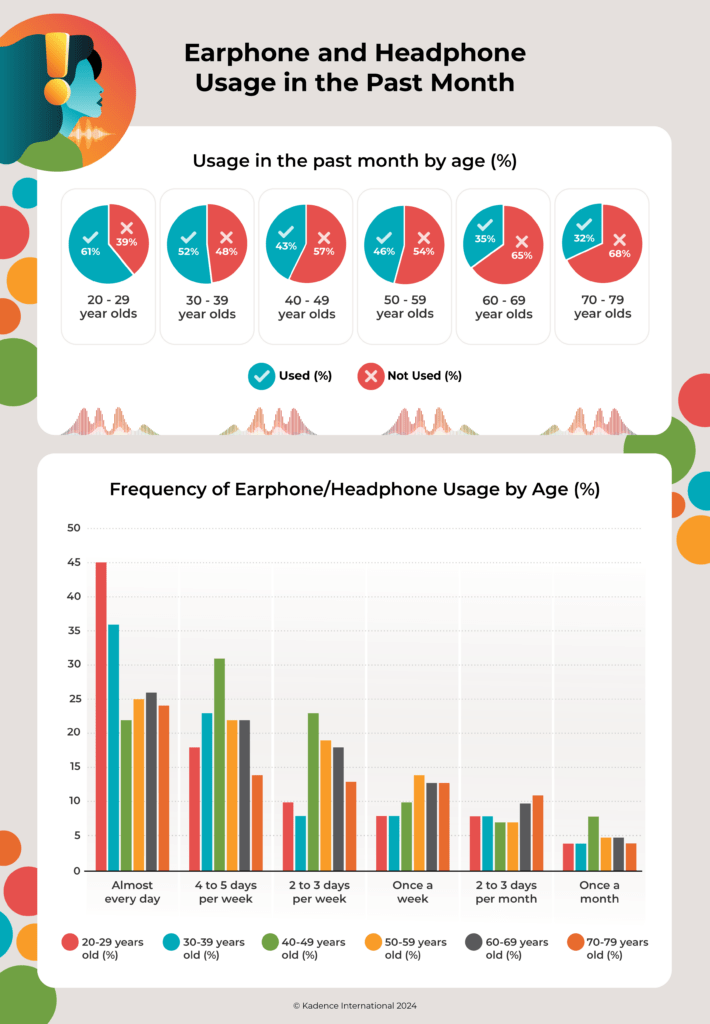
Key Findings
The 2024 Ear Survey reveals crucial trends in earphone and headphone usage in Japan:
- Overall Usage: 45% of respondents used earphones or headphones in the past month. Usage is significantly higher among younger demographics, with 61% of individuals in their 20s using these devices compared to 32% of those in their 70s.
- Frequent Use: 31% of users reported daily usage, highlighting these devices’ integral role in daily activities, especially for younger users.
- Wireless Preference: There is a marked preference for wireless earphones, particularly among younger users, with 65% of individuals in their 20s favoring them.
Usage Scenarios
Understanding the context when earphones and headphones are used provides deeper insights into consumer behaviour:
- Listening to Music: 71% of respondents use earphones or headphones.
- Watching Videos: 50% use them to watch videos, emphasising their role in visual media consumption.
- Listening to the Radio: Despite the proliferation of digital media, 21% of users still listen to the radio.
- Playing Games: Gaming is another significant use case that enhances the immersive experience.
The pandemic accelerated the adoption of earphones and headphones, particularly for teleworking and online education, contributing to higher usage rates for watching videos and playing games.
Market Insights
For brands in Japan’s audio and tech industry, these findings present both challenges and opportunities:
- Adoption of Wireless Technology: The strong preference for wireless earphones, especially among younger users, highlights the importance of investing in wireless technology. To meet consumer expectations, brands should focus on improving battery life, connectivity, and sound quality.
- Targeted Marketing Strategies: The generational divide in usage patterns suggests brands can benefit from tailored marketing strategies. Younger users may respond well to campaigns highlighting technological advancements and lifestyle integration, while older demographics might prefer comfort and hearing protection features.
- Product Innovation: The varied usage scenarios indicate a need for versatile products. Earphones and headphones that transition seamlessly between music, video, and gaming modes and include features like noise cancellation and health-conscious designs can appeal to a broad audience.
Case Study: Sony WH-1000XM4 Headphones
Image Credit: Sony
Background
Sony, a major player in the audio industry, sought to improve its flagship noise-cancelling headphones by integrating advanced features to enhance the user experience. The goal was to develop headphones with superior sound quality, adaptive noise cancellation, and smart listening capabilities.
Product Development and Outcome
The Sony WH-1000XM4 headphones feature leading noise-cancelling technology with Dual Noise Sensor technology. These headphones adapt to the user’s environment with Adaptive Sound Control, automatically adjusting ambient sound settings. They offer superior sound quality through Edge-AI, which enhances real-time audio restoration. These innovations have positioned Sony’s WH-1000XM4 as a top choice for consumers seeking high-performance headphones to seamlessly integrate into their lifestyle.
Anxiety About Hearing Loss
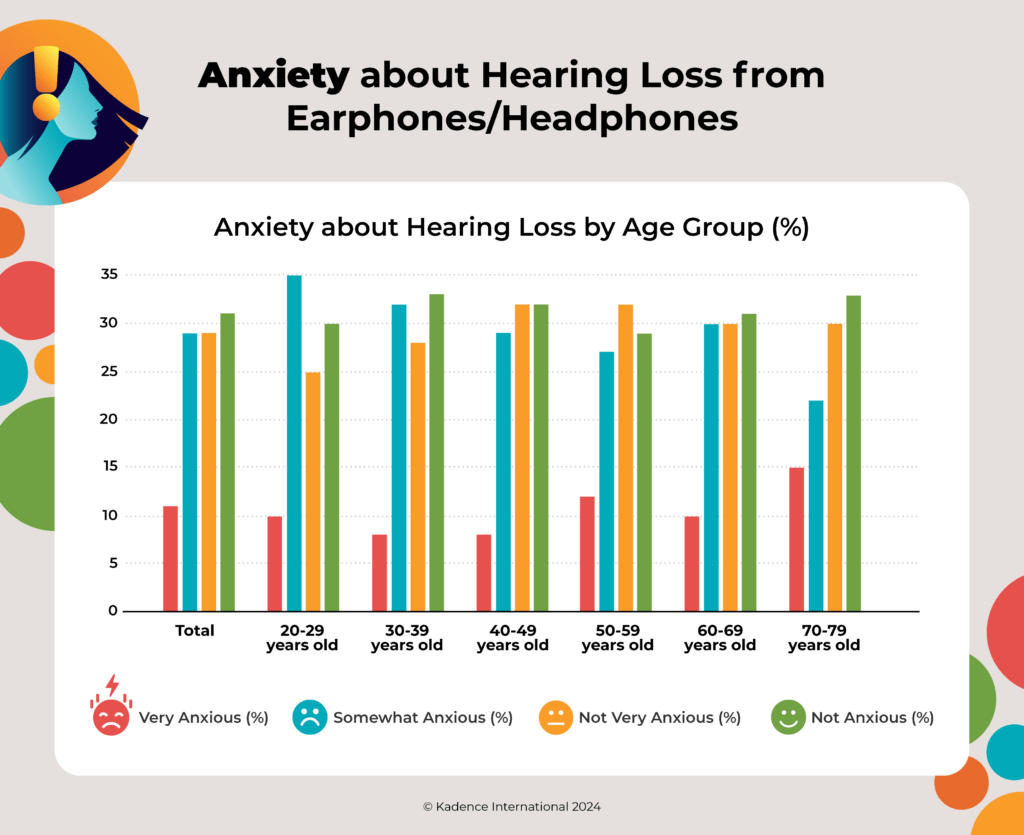
Key Findings
A significant insight from the 2024 Ear Survey is the level of anxiety about hearing loss associated with earphone and headphone use:
- General Anxiety: 40% of respondents expressed anxiety about potential hearing loss.
- Age-Specific Concerns: Anxiety is particularly high among younger demographics, with 45% of individuals in their 20s reporting concerns.
Psychological Impact of Hearing Loss Anxiety
Anxiety about hearing loss can profoundly affect mental health and daily behaviour:
- Increased Stress: Constant worry about hearing loss can elevate stress levels, manifesting difficulty concentrating, irritability, and sleep disturbances.
- Behavioural Changes: Anxiety may cause individuals to alter their listening habits, reducing earphone use or frequently adjusting volumes to avoid risks.
- Social Impact: Fears about hearing impairment can affect social interactions, leading to isolation or avoidance of social situations where earphones are common.
Brand Opportunities
The widespread anxiety about hearing loss presents a unique opportunity for brands:
- Product Development: Develop earphones and headphones that address hearing health concerns. Features like noise-cancelling technology, built-in volume limiters, and real-time sound level monitoring can reduce the risk of hearing damage.
- Educational Campaigns: Focus marketing strategies on educating consumers about safe listening practices. Collaborate with health organisations to disseminate information about hearing protection and the benefits of advanced audio technology.
- Reassurance Messaging: In advertising campaigns, emphasise products’ safety features and highlight endorsements from audiologists and health experts to build trust.
- Community Engagement: Create forums and platforms where users can share their experiences and strategies for maintaining hearing health and enhancing brand loyalty.
Awareness of Hearing Loss Risks
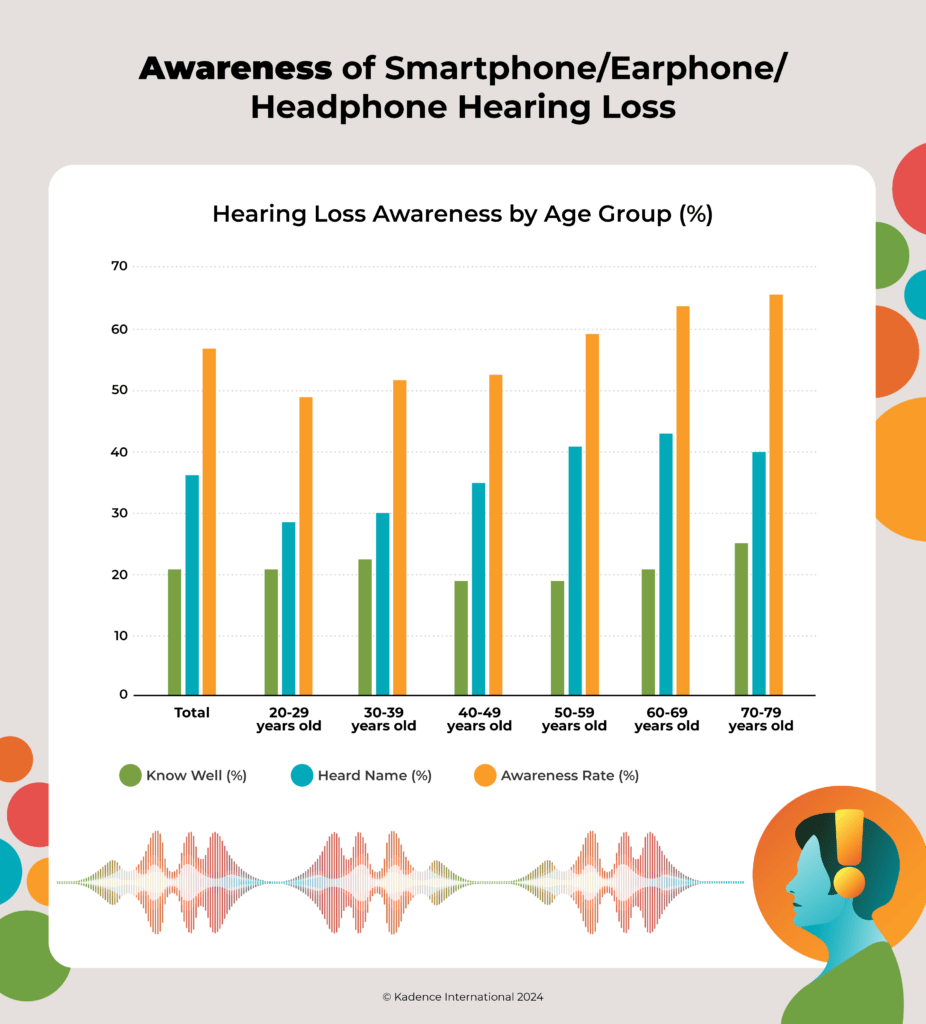
Key Findings
Awareness of the risks associated with earphone and headphone use is crucial in mitigating potential hearing damage:
- General Awareness: 42% of respondents are aware of “smartphone hearing loss,” while 57% are aware of hearing loss related to earphone and headphone use.
- Age-Specific Awareness: Awareness is higher in older age groups, with 50% of respondents in their 60s and 52% in their 70s reporting awareness of these risks.
Educational Resources
- Online Portals and Apps: Websites and mobile applications dedicated to hearing health offer interactive tools for assessing hearing risk and monitoring sound exposure. Two examples are Mimitakara myHearing App and Eargym. The Mimitakara myHearing App offers free hearing tests, personalised settings for different noise environments, and lifetime audiologist support, allowing users to customise their hearing experience based on their unique lifestyle needs. Similarly, Eargym provides interactive auditory training through immersive audio games designed to improve core hearing skills by training the brain to process sounds more effectively. Both apps emphasise remote accessibility and personalised care, making advanced hearing health resources readily available.
- School and Community Programs: Educational programs in schools and communities provide early education on hearing health, shaping lifelong safe listening habits.
Market Insights
For brands, consumer education is both a public health responsibility and a strategic opportunity:
- Building Trust: Educating consumers about hearing health builds trust and positions brands as caring and responsible. Transparent communication about risks and mitigation steps can strengthen consumer relationships.
- Enhanced Brand Reputation: Proactively addressing hearing health can differentiate brands in a crowded market, enhancing their reputation among health-conscious consumers.
Strategies for Collaboration
- Partnering with Health Organisations: Collaborate with health organisations to co-develop educational campaigns and resources, leveraging their expertise and credibility. Public health initiatives are pivotal in raising awareness about hearing loss risks; brands can partner with these initiatives. Here are two popular ones:
- World Hearing Day: Organised by the WHO on March 3rd each year, this event aims to raise awareness about hearing loss and promote hearing care globally.
- Safe Listening Initiatives: Programs like WHO’s “Make Listening Safe” educate young people about the safe use of personal audio devices.
- Integrating Awareness into Marketing Efforts: Incorporate hearing health messages into marketing campaigns to reach a broader audience and highlight product health features.
- Innovative Product Features: Develop products with built-in health features, such as volume limiters and sound exposure trackers, and market these as essential tools for maintaining hearing health.
Practical Tips for Preventing Hearing Loss
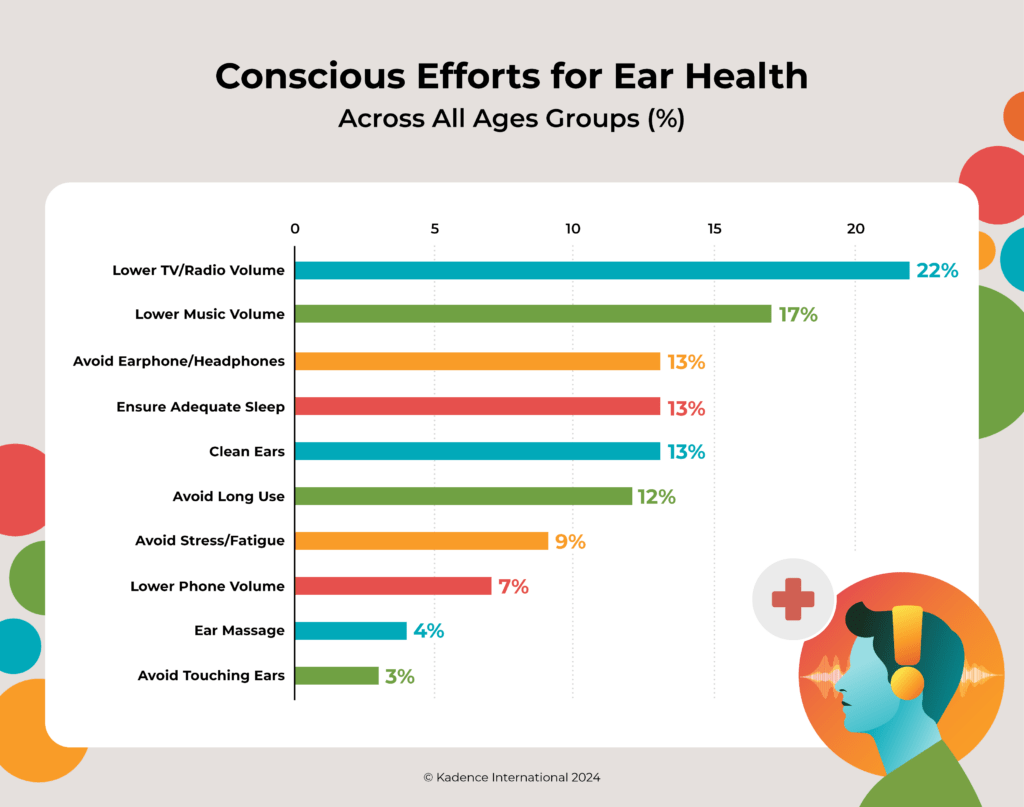
Recommendations Based on Survey Findings
For brands in Japan’s audio and tech industry, addressing hearing health concerns is both a corporate responsibility and a strategic advantage:
- Limiting Volume and Duration
- Volume Control Features: Integrate automatic volume limiters in earphones and headphones to ensure users do not exceed safe listening levels. This can be a key selling point for health-conscious consumers.
- Usage Duration Alerts: Develop features that monitor and alert users about the duration of their earphone/headphone use—timely reminders to take breaks help reduce the risk of hearing damage from prolonged exposure.
- Using Noise-Canceling Headphones
- Promote Noise-Canceling Technology: In marketing campaigns, emphasise the benefits of noise-canceling headphones. By reducing background noise, these headphones allow users to listen at lower volumes, thereby protecting their hearing.
- Enhanced Noise-Canceling Capabilities: Invest in research and development to improve noise-cancelling technology, making it more effective and accessible across different price points. This can help cater to a wider audience while promoting safer listening habits.
- Regular Hearing Check-Ups
- Awareness Campaigns: Collaborate with health organisations to promote the importance of regular hearing check-ups. Use your brand’s platform to share information on where and how consumers can get their hearing tested.
- Integrated Health Features: Explore integrating hearing health assessments into smart audio devices. For instance, earphones and headphones could periodically assess hearing ability and provide feedback or recommendations for a professional check-up.
Technological Advancements
Innovation in hearing protection technology is crucial for addressing consumer concerns and enhancing product offerings:
- Innovations in Hearing Protection
- Adaptive Sound Technology: Develop earphones and headphones that adapt sound levels based on the user’s environment, ensuring optimal volume without compromising hearing health.
- Hearing Protection Algorithms: Implement advanced algorithms that dynamically adjust sound output to protect hearing. These can be marketed as premium features that prioritise user health.
- Apps and Tools for Monitoring Sound Exposure
- Hearing Health Apps: Create mobile apps that sync with audio devices to monitor and report on sound exposure. These apps can provide personalised recommendations and track listening habits over time.
- Sound Exposure Trackers: Integrate sound exposure tracking into existing health and fitness apps. Providing users with comprehensive health data, including hearing health, can enhance your products’ overall value proposition.
Case Study: Apple AirPods Pro
Image Credit: WCCF Tech
Background
Apple aimed to enhance its popular AirPods series by integrating advanced features to improve sound quality and user comfort. The goal was to develop earphones that offer exceptional audio performance while incorporating health-conscious features to appeal to a broad consumer base.
Product Development and Outcome
Apple’s AirPods Pro integrates several advanced technologies to provide a superior listening experience. Key features include Active Noise Cancellation (ANC) and Transparency mode, allowing users to switch between immersive sound and environmental awareness. The earphones also feature Adaptive EQ, which tunes the music to the shape of the user’s ear, and Personalised Spatial Audio with dynamic head tracking for an immersive theatre-like sound experience.
In addition, the Noise app on the Apple Watch tracks decibel levels of ambient sounds, helping users identify when sound levels in their environment or from their headphones could negatively affect their hearing. When configured on an Apple Watch and connected with compatible headphones, the Control Center shows if the sounds playing through the headphones reach unsafe levels. All information is securely stored in the Health app on iPhone, providing easy access to data whenever needed. These advancements have reinforced Apple’s position as a leader in innovative audio technology, offering users high-quality, comfortable, and versatile earphones.
Consumer Behavior Trends
Understanding and responding to consumer behaviour trends is vital for designing products that meet their needs and preferences:
- Adoption of Safe Listening Practices
- Educational Content: Use content marketing to educate consumers about safe listening practices. Blog posts, videos, and social media campaigns can highlight tips for maintaining hearing health and the features of your products that support these practices.
- Community Engagement: Foster a community around safe listening habits. Encourage users to share their experiences and tips, creating a mutual learning and support platform.
- Implications for Product Design and Marketing
- User-Centric Design: Design products with the end-user in mind, focusing on comfort, usability, and health features. Conduct user research to understand the specific needs and preferences of different demographics.
- Health-Focused Marketing: Position your brand as a leader in hearing health by highlighting your products’ protective features. Use testimonials and endorsements from health professionals to build credibility and trust.
- Continuous Improvement: Stay abreast of the latest research and technological advancements in hearing health. Regularly update your product offerings and marketing strategies to reflect new insights and maintain a competitive edge.
Case Study: Bose QuietComfort Earbuds
Image Credit: Mashable
Background
Bose, renowned for its audio technology, aimed to develop earbuds delivering the best noise-cancelling experience. The goal was to create a product that offers superior sound quality and comfort, meeting users’ needs in various environments.
Product Development and Outcome
The Bose QuietComfort Earbuds feature industry-leading noise-cancelling technology with 11 levels of noise control, allowing users to personalise their listening experience. These earbuds deliver high-fidelity audio using active and passive noise reduction techniques. Bose’s proprietary StayHear™ Max tips ensure a secure and comfortable fit for prolonged use. The result is a product that excels in sound quality and user comfort, maintaining Bose’s reputation for audio excellence and meeting diverse consumer needs.
Final Thoughts: Proactive Measures to Maintain Hearing Health
Maintaining hearing health in our increasingly digital and audio-centric world requires proactive measures from consumers and brands. As highlighted throughout the 2024 Ear Survey, there is a clear need for better education, innovative product features, and robust health campaigns to prevent hearing loss. Brands in Japan’s audio and tech industry are uniquely positioned to lead this charge, offering solutions that safeguard hearing health while meeting consumer demands. As evidenced by this study, emphasising hearing health as a core aspect of product development and marketing strategy is not just good for consumers—it’s good for business.
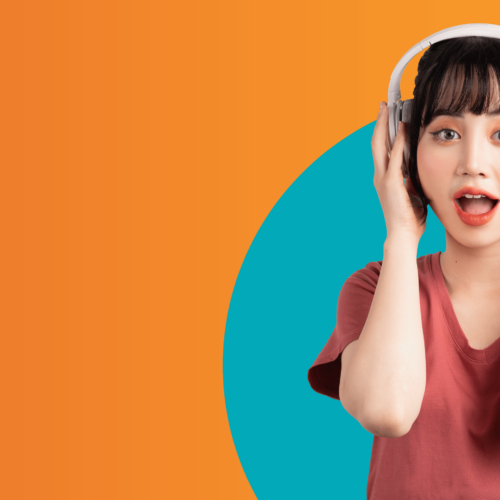


 Senior Marketing Executive
Senior Marketing Executive Sales & Marketing
Sales & Marketing General Manager PR -Internal Communications & Government Affairs
General Manager PR -Internal Communications & Government Affairs Vital Strategies
Vital Strategies
 Customer Intelligence Director
Customer Intelligence Director